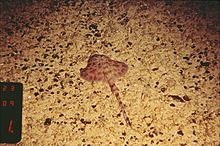Fenestraja plutonia
| Fenestraja plutonia | |
|---|---|

| |
| Scientific classification | |
| Domain: | Eukaryota |
| Kingdom: | Animalia |
| Phylum: | Chordata |
| Class: | Chondrichthyes |
| Subclass: | Elasmobranchii |
| Superorder: | Batoidea |
| Order: | Rajiformes |
| Family: | Gurgesiellidae |
| Genus: | Fenestraja |
| Species: | F. plutonia
|
| Binomial name | |
| Fenestraja plutonia (Garman, 1881)
| |
| Synonyms | |
| |
Fenestraja plutonia is a species of
continental slope in the western Atlantic Ocean between the coasts of the southern United States and Suriname.[1]
Etymology
The underworld windowskate's genus name, Fenestraja, comes from a combination of two words. Fenestre is a
Taxonomy

The underworld windowskate was initially described by
synonym for the underworld windowskate, once the species was officially moved from Raja to Fenestraja.[7]
Description
The underworld windowskate has a
ventral surface is yellow-white, and the tail has several dark bands.[8]
Distribution and habitat
According to the
Puerto Limon, and the second from the South American continental shelf near Caracas, Venezuela, to Paramaribo, Suriname.[1]
Outside of these general ranges, specimens have been collected from the waters off Colombia, Ellesmere Island, in the eastern Gulf of Mexico, and James Bay, Canada.[9] Individuals have also been spotted by divers in southern Mexico, and in 1891 a specimen supposedly belonging to F. plutonia was collected from the California coast, even though the underworld windowskate is overwhelmingly an Atlantic species.[9][10]
See also
References
- ^ IUCN: e.T161642A124520072. Retrieved 18 January 2021.)
{{cite journal}}: CS1 maint: multiple names: authors list (link - ^ Froese, Rainer and Pauly, Daniel, eds. (2011). Species of Fenestraja in FishBase. February 2011 version.
- ^ Romero, P., 2002. An etymological dictionary of taxonomy. Madrid, unpublished.
- ^ William Hansen, Classical Mythology: A Guide to the Mythical World of the Greeks and Romans. Oxford University Press, 2005
- ^ a b Garman, S. 1881 (Apr.) Report on the selachians. Reports on the results of dredging, ... along the Atlantic coast of the United States during the summer of 1880, by the U. S. Coast Survey Steamer "Blake," Commander J. R. Bartlett, U. S. N., commanding. XII. Bulletin of the Museum of Comparative Zoology v. 8 (no. 11): 231–237.
- ^ Fowler, H. W. 1947 (June) A new skate from the Gulf Stream off east Florida. The Fish Culturist v. 26 (no. 10): 73–75.
- ^ McEachran, J.D. and K.A. Dunn, 1998. Phylogenetic analysis of skates, a morphologically conservative clade of elasmobranchs (Chondrichthyes: Rajidae). Copeia 1998(2):271–290.
- ^ a b Kells, Val., Carpenter, Kent. A Field Guide to Coastal Fishes From Maine to Texas. 2011. Johns Hopkins University Press. pg 86.
- ^ a b Global Biodiversity Information Facility Records. 6 June, 2014
- ^ Global Biodiversity Information Facility, Occurrence Records. 2 May 2015

